RESTORED ANTIQUE EARLY HOPF 4/4 GERMAN TRADE VIOLIN WITH RESTORED VINTAGE GSB HARD WOOD CASE - CIRCA 1870
You are invited to purchase a very nice antique handcrafted 4/4 (full size) early Hopf trade violin from Germany, which has been repaired, re-graduated, updated and fully restored to playability. Included with the violin is a restored felt-lined vintage GSB hard wood case. No bow or other accessories are included.
We have completed a series of relatively difficult repairs and restorative actions associated with this violin including a re-graduation of the top plate interior and bass bar replacement (See details below). The violin has also been upgraded and modernized with a new Ebony chin rest, new Ebony fingerboard, new Ebony nut and endpin, modern strings and Wittner geared pegs making it ready to be played and enjoyed by its new owner.
VIOLIN MAKER'S STAMP & REPAIR LABEL:
This violin bears the following burnished-in stamp of the Hopf Violin Guild on the top back of the violin under the button (See accompanying image):
"HOPF"
In addition, this violin bears a repair label from our workshop found inside the violin under the left f-hole (See image):
THE OLDE VIOLIN SHOPPE
HAMILTON, MONTANA USA
ANTIQUE & VINTAGE VIOLIN REPAIR,
RESTORATION & REGRADUATION
REGRADUATED VIOLIN ANNO 2025
VIOLIN ORIGIN & ESTIMATED DATE OF MANUFACTURE:
The dynasty of Hopf family luthiers is known to have consisted of somewhere between 18 and 40 individuals (Note: Some references say upward of 50 individuals) who were members of the Hopf String Instrument Guild or empire, which operated from the late 17th Century on through the late 19th Century in and around the town of Klingenthal in the German province of Vogtland (now located in the Czech Republic).
The founding member of the Hopf family was Caspar Hopf (1650-1711). He was later followed by his son David Christian Hopf (birth and death dates unclear) and his grandson, David Hopf (1762-1786). This family of luthiers produced fine German cellos, violas and violins. Many of the violins were stamped under the button on the outside top of the back plate with the guild name "HOPF" and some productions even had the name stamped inside the violin as well.
The Hopf family members overall were known to be quite industrious, literally building tens of thousands of instruments under the family signature in a production-line assembly with individual scroll cutters, back and top carvers, rib makers, and even peg makers, etc. The work produced by the family guild is superficially in the Stainer style, but with noticeably squared-off upper and lower bouts.
As time went on, other violin making families joined in with the numerous Hopfs, with members of the Dorfel, Hoyer and Glass families being particularly significant. But, by the mid-19th Century, the boom in production had already reached its peak followed by a very dramatic bust and by the year 1887, the Hopf family guild in Klingenthal had essentially ceased to exist.
Based in part on the amount of repair work it took to restore this violin to the point of playability (see below for details) and the type of wood and methods used in its original production, we estimate that this particular Hopf violin likely dates from Circa-1870.
KEY PHYSICAL FEATURES:
* A warm, very attractive Walnut-brown spirit varnish.
* Two piece flamed Maple back with ribs of flamed Maple to match the back (See images).
* Two piece Spruce top with a wider grain pattern at the edges with a tighter grain pattern towards the central seam (See images).
* Top plate has a moderate arch.
* Edges of the top and bottom plates near the purfling with a pronounced dip in vertical profile.
MEASUREMENTS:
* Length Overall (Loa): 23"
* Length of the body (LoB): 14"
* Rib Height: 1.25"
* Max Width of Upper Bout: 6 1/8"
* Avg. Width at Waist or C-Bout: 4 3/8"
* Max. Width of Lower Bout: 7 5/8"
NATURE OF REPAIRS & RESTORATION:
This antique violin was received by us in overall apparently good structural condition, but with a loose neck. It was also in need of a good external and internal cleaning and new varnishing. The original fingerboard was found to be of inferior quality and poorly carved, being made of an unknown wood type (not Ebony) and painted black. It was also set so low that it showed evidence of rubbing the crown of the top plate wood under the fingerboard. There was also evidence of previously repaired cracks in the lower bout.
Once the top plate was removed from the violin, we discovered that there was a relatively short, improperly situated and poorly formed carved-in bass bar present. Thus, a new properly designed bass bar would need to be installed. Also, the interior of the top plate was roughly carved with residual ridges and valleys necessitating the need to re-graduate the top plate for a more smooth and relatively consistent thickness. Only the lower two corners were blocked by the maker with the upper two corners left unblocked. In addition, the previously repaired cracks in the top plate were not cleated inside and the central seam in the bottom plate was not cleated by the original maker (See image of the violin interior prior to repairs).
Following is a summary of the actions taken by us to repair and restore this antique Hopf violin to full playability:
1. Once the top plate was removed from the violin, all previously glued cracks were cleaned, re-glued with Hide Glue and cleated. All other open cracks were cleaned, glued with Hide Glue and cleated (See image of the interior of the top plate following repairs). All cracks in the top plate are now fully stabilized.
2. Only the rear 2 corners were blocked by the maker. We blocked the upper 2 corners. Thus, now all four corners are blocked (See image showing the blocking).
3. The poorly designed carved-in bass bar in the top plate was removed and the interior of the top plate was re-graduated to a relatively uniform thickness and smooth surface. Then, a new properly designed and profiled bass bar was installed in the proper location on the inside of the top plate (See image of the top plate interior with the new bass bar).
4. The loose neck was was reset to the proper height and re-glued to the body of the violin.
5. The original fingerboard was removed from the neck and a new Ebony fingerboard was installed and properly profiled and trimmed to fit the neck. The top of the fingerboard was sanded smooth. At this time a new Ebony nut was added to the violin and properly trimmed in size and height. Grooves for the strings were set in concert with standard design specifications.
6. At this time, the exterior surfaces of both the top and bottom plates as well as the ribs and scroll box were wet sanded with successive grades of sandpaper (400, 600 followed by 1,000 git) thereby removing most age related surface imperfections. The surfaces were then cleaned with denatured Alcohol and Walnut stain was added to areas needing it. This was followed by two (2) successive coats of Walnut Spirit Varnish to restore all exterior surfaces to a like new condition. A coating of French Polish was added to all exterior surfaces of the violin as a final cosmetic treatment.
7. The top plate was re-glued to the ribs using Hide Glue. Note: Before the top plate was restored to the violin, we added a repair label from our shop to the inside of the bottom plate (See images).
8. We re-installed the original Ebony saddle and added a new Ebony endpin onto the violin. In addition, a new full-size Guarneri-style Ebony Chinrest was added to the violin along with the original Ebony tailpiece that came with the instrument.
9. The pegbox was fitted with Wittner Finetune geared Pegs (Made in Germany). These geared pegs negate the need for fine tuners on the tailpiece as they are permanently set within the pegbox and have an 8:1 gear ratio, making for very precise tuning. Only the central knurled spool segment of the peg rotates so peg slippage is prevented. So once the Wittner pegs are set, they are not designed to be removed from the pegbox. The geared pegs are also unaffected by temperature and humidity changes.
NOTE: Conventional wood peg slippage is a big problem with most violins, something that a player definitely does not want to happen in the middle of a concert solo in front of a large audience. Wittner geared pegs totally eliminate peg slippage so one can play the violin even with vigor without worry.
10. Finally, we completed the setup of the violin by properly fitting a new Teller Germany Maple bridge, new Spruce soundpost along with a new set of Pirastro Chromcor strings made in Germany.
All of the aforementioned repairs have resulted in a completely restored, re-graduated and upgraded Hopf violin that has significantly improved the overall tonal response and sound quality of this instrument. Thus, this antique instrument that could have easily been lost to time has been fully repaired, improved and reborn to live a second life in the present.
VIOLIN CASE:
Included with the violin is a recently refurbished GSB felt-lined hard wood case with brass hardware and carrying handle. The case is suitable both for safely and securely shipping the instrument to its new owner and for use in storing and transporting the instrument after it is received.
PURCHASE:
The Montana Logger is very pleased to offer this professionally repaired, upgraded and completely restored Hopf German trade violin with case for a very reasonable buy-it-now price. We will also entertain reasonable offers for this refurbished antique German-made violin that dates from Circa 1870.
PAYMENT: Payment is due within 3 days of purchase. Prompt payment is always very much appreciated.
























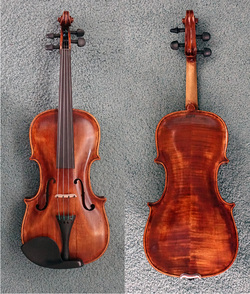
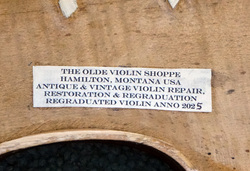

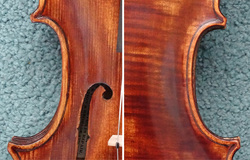
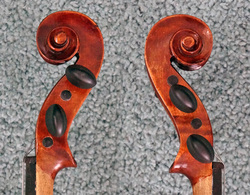
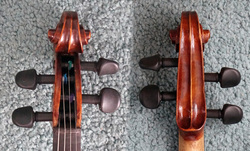

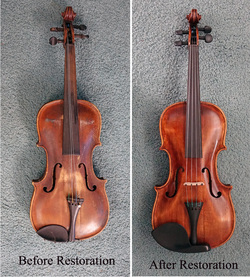
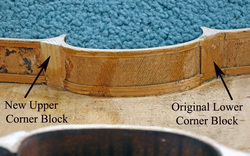
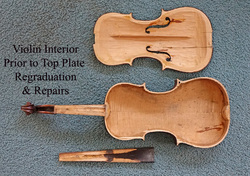

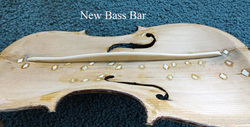
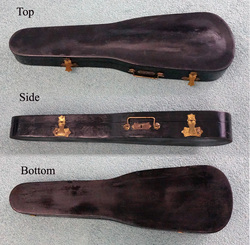
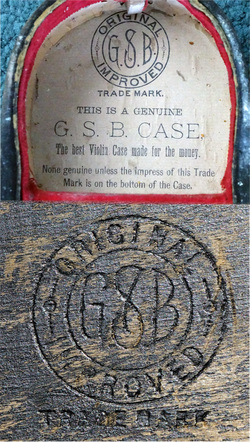








0 Comment
Leave Comment